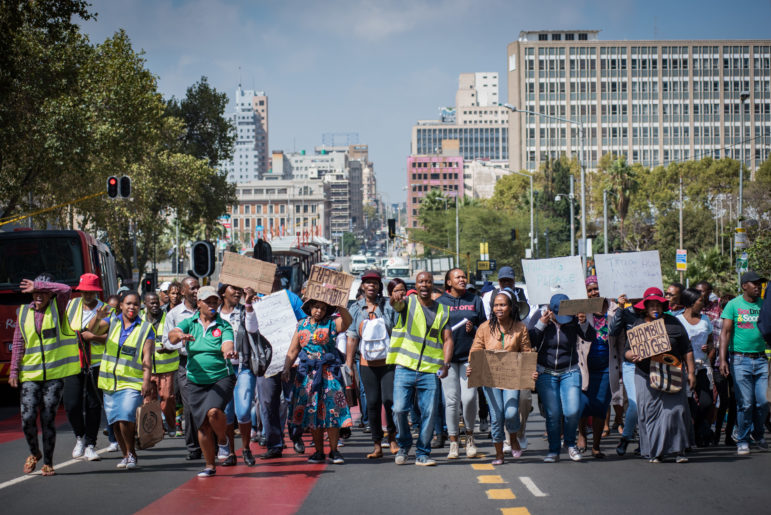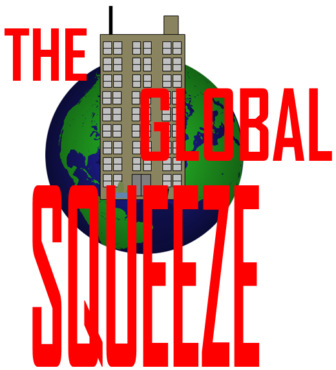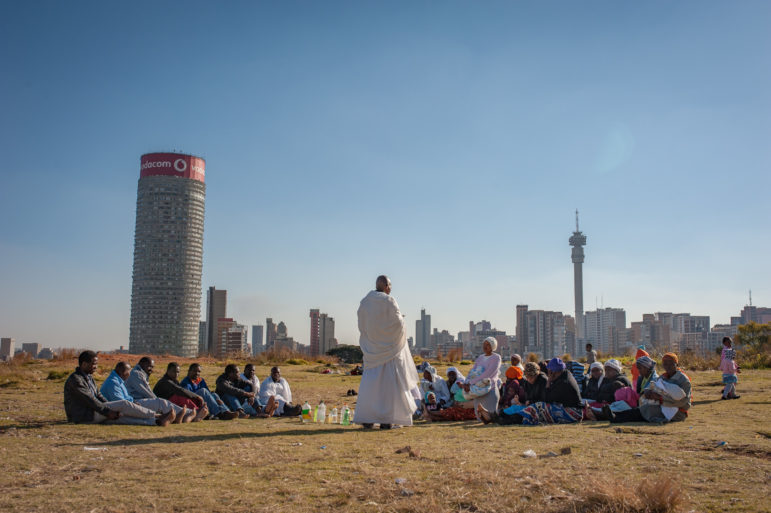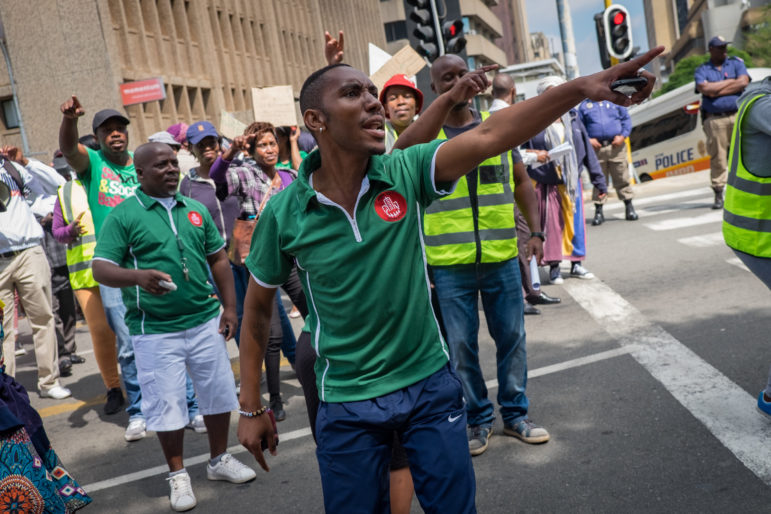
Daylin Paul
March 27, 2018: The Inner-City Federation marching through central Johannesburg.
This story is the second in a five-part series about displacement and the advocates who are battling it around the world.
* * * *
Syabonga Mahlangu asks that we meet at the Socio-Economic Rights Institute of South Africa offices in Braamfontein, just around the corner from the Nelson Mandela Bridge and a block away from Wits University’s main campus. This part of the now trendy neighborhood is still a little sketchy, but it’s far safer and cleaner than it was just a few years ago. Its once dilapidated buildings now host coffee shops, designer clothing stores, art houses and student accommodation for the nearby university. It’s a Saturday and, in the distance, you can hear the sounds of music and laughter from the uber-cosmopolitan, open-air Neighbourgoods Market just a block away. Braamfontein and the Maboneng district are the flagship success stories of the city’s regeneration program.
Originally from Richards Bay, a harbor town on the east coast of South Africa, Mahlangu, like so many South Africans and Africans from across the continent, moved to Johannesburg seeking better economic opportunities than he could find in his hometown. That was 10 years ago. He was 19 at the time. The City of Gold, however, has not been as kind as he had hoped and he survives by working “piecemeal jobs,” as he calls them, within the central business district. “If I had to live in Soweto or Tembisa (townships on the outskirts of Johannesburg) it would be like I was working just just to pay for transport,” he tells me.
Mahlangu also serves as the general secretary of the Inner-City Federation which was formed in 2015 with the assistance of the Socio-Economic Rights Institute, or SERI, which does advocacy work and litigates court cases on behalf of inner-city residents. Not officially registered as a nonprofit organization, the federation is a something of a hybrid: acting as both a support group for beleaguered residents to share their experiences of life in the inner city and their struggles for basic services and against eviction, as well as an umbrella organization for the residents of over 60 buildings in the inner-city area to mobilize under as a single, unified whole during protests and important court hearings.
It’s a Saturday afternoon and Mahlangu is sitting on a sofa in the reception area of SERI’s offices when we meet. He has a stack of flyers perched on the armrest of the sofa next to him. They advertise a protest that will happen in a few days’ time, and during the interview his phone is constantly ringing as people try to find out more details about the march. “The federation was formed when we found that there were many people suffering like us.” he tells me. “On Tuesday we are marching to Civic Boulevard,” where the offices of the mayor and the Johannesburg Metropolitan Municipality are located. “We are marching to demand dialogue with the city officials. To demand basic services like water and electricity. We want public and social housing within the city, not in the townships.”
Struggling for a foothold in the city’s center
Access to informal employment opportunities, as well as proximity to hospitals and schools are just some of the reasons why inner-city residents refuse to be moved from their homes. The residents, mostly Black people from rural and small town South Africa, as well as migrants from Mozambique, Zimbabwe and other parts of sub-Saharan Africa, are amongst the poorest of Johannesburg’s citizens. They rely on the infrastructure and the amenities available in the inner city in order to survive.

Despite the desperate circumstances they leave and their dreams of making better lives for themselves in Johannesburg, many find that the city is less welcoming than they had hoped. From the early 2000’s onwards the impasse between low-income residents on one side and the government, landlords and property developers on the other, has only widened, many live under the constant threat of eviction. Indeed, this is one of Mahlangu’s motivations for working as an activist. “I don’t want to see people in the future suffering like me. I’m looking at the future, not just for me and my children, but for everybody. I know that to live under the threat of eviction is something that’s sensitive. I truly understand and I truly know the pain of being under the threat of eviction.”
The image of the Johannesburg skyline in popular imagination is typically dominated by two structures: Hillbrow Tower and the Ponte City apartment building in Berea. Both iconic skyscrapers were constructed in the 1970s at the zenith of the apartheid regime and the “New York of Africa’s” economic power. Both have come to symbolize its fall from grace.
For most Johannesburgers the landmarks are indelibly linked to the neighborhoods that they tower over. Notorious for their high rates of crime, poverty and urban decay, inner city neighborhoods like Yeoville, Berea and most especially Hillbrow are areas that most middle-class South Africans and tourists try to avoid. Social-media groups and bloggers wax lyrical about days gone by when the neighborhoods were in their prime and well-heeled, and White South Africans were their residents. Their nostalgia often drifts into casual racism and xenophobia, lamenting the decline of their onetime neighborhoods because of the influx of the poor Black people from the countryside and across the continent into inner-city Johannesburg in the dying days of apartheid.
Bheki Vilakazi is the chairman of the Inner-City Federation. We’re standing outside the dilapidated art-deco apartment building in Yeoville where he lives. In the decades before the abolition of apartheid, the suburb was the bohemian capital of South Africa. Art galleries, record stores, bars and live music venues littered Raleigh and Rockey Streets, just three streets away from where Vilakazi has been living for the last two decades. Vilakazi’s experience of Yeoville has been decidedly less entertaining.
He tells an all-too-common story of how, when he got to Johannesburg more than a decade ago, things were initially fine. His rent was being paid to property management agents and services like water and electricity were uninterrupted. Then, about 10 years ago, a dispute between the owner of the property and the agents led to a breakdown in the relationship. A man claiming to be the cousin of the landlord started coming around monthly to collect the rent and utility fees. But the municipality began suspending the water and electric services, claiming that tenants had not being paying. When Vilakazi and other residents confronted him to ask about what he had being doing with their money, he ran away and was not heard from again. In the following years different people began visiting the apartments, claiming ownership until someone came in and started sub-dividing the apartments into separate rooms in order to maximize rental income from the building.
By 2011, security guards were coming to collect the rent in cash until the residents, who were being harassed by police for not paying their utility bills and having illegal electrical connections, insisted that they would only give over the rent if they could do so at the police station and receive a receipt. The security guards refused—and they, too, were not heard from again.

Daylin Paul
8 July, 2016: A religious leader leads a service on hilltop in Yeoville with Ponte City (left), Hillbrow Tower (right) and the inner-city skyline of Johannesburg in the background.
Hijacked buildings
“Hijacked buildings” are a hallmark of Johannesburg’s inner-city housing problem. These are buildings abandoned by owners who either died or left the country during the sanctions of the 1980’s or retreated to the suburbs north of the city after a wave of urbanization into central Johannesburg followed the dissolution of the Bantustans—land in rural South Africa set aside by the apartheid government to serve as homelands for Black South African’s in order to keep them out of the cities. Others simply abandoned the properties after giving up hope of ever collecting an income from them. Building hijackers then stepped into the void left by landlords, sending enforcers to collect money without having any legal right to the buildings or providing basic services or maintenance. Thus the buildings have been occupied but left to decay and lack security.
The situation facing the Inner City Federations’s members got worse after the 2016 municipal elections and the arrival of a new mayor, Herman Mashaba. Mashaba, a cosmetics millionaire and self-described capitalist, started his tenure as mayor by promising to rid the city of hijacked buildings using “shock and awe” tactics, a military doctrine based on the use of overwhelming power and spectacular display of force to paralyze the enemy’s will to fight. The term came into popular use after U.S. military officials used it to describe the initial phases of the 2003 invasion of Iraq. His use of such rhetoric and his willingness to blame the situation in the inner-city on foreign nationals saw him heavily criticized by civil rights groups, especially in the wake of xenophobic violence in 2008 and 2015,
The hijacked buildings are either turned into shops and offices, student housing or “low-cost housing” which is still priced way above what most people who are already living in the city can afford. Thus, they get moved out and business, students from the university and people earning more money get moved in.
Amnesty International’s regional director for southern Africa, Deprose Muchena, was even quoted as saying “divisive fear-mongering has become a dangerous force in world affairs. Whether it is leaders like [President] Trump and [Philippines President Rodrigo] Duterte or prominent regional figures like Herman Mashaba, more and more politicians are wielding a toxic agenda that hounds, scapegoats and dehumanizes entire groups of people.”
For some, the evictions bring back ugly memories of South Africa’s troubled past. Vilakazi came to Johannesburg from Piet Retief, a small town in Mpumalanga province near the border with Swaziland, around 25 years ago, just before South Africa’s transition to democracy and just after the abolition of the racially based Group Areas Act which prevented Black people from staying or owning property in “White-designated areas”, like Yeoville, Hillbrow and Berea.
The Group Areas Act left a deep scar on the psyche of non-White South Africans. Just five miles from the city centre lies Sophiatown, once a diverse and culturally vibrant suburb that was home to Black, Indian, Chinese and mixed-race families. Its residents were forcibly removed by police in 1955. Their homes were then systematically destroyed and a new, Whites-only suburb named Triomf (“Triumph” in Afrikaans) was built on the ruins of their community. After 1994, the suburb was again renamed Sophiatown and legislated racial segregation no longer exists, but it serves as a painful reminder of the trauma of forced removals.
This is, in part, why evictions elicit such a strong emotions from the low-income, predominantly Black residents of the inner-city. “All we want is to keep the community together. Our primary goal is to get reasonable rates to keep living in the city. We want to stop being evicted from our homes. We want to keep our community.” says an impassioned Vilakazi.
The Red Ants come in
These evictions happen after court orders granting the owners permission to remove tenants has been granted. Police and the infamous Red Ant Security Relocation and Evictions services—a private security company specializing, as their name implies, in evictions—then move in to force residents out. The Red Ants are notorious for their brutality, and Mahlangu said that ICF members have suffered injuries and had their possessions destroyed during evictions. In Bekezela informal settlement, near the train station in central Johannesburg, women reported being sexually assaulted by the Red Ants during the eviction.
Mashaba’s plans for the inner city took a serious setback in mid-2017 when a Constitutional Court hearing set aside an eviction order for 184 residents of the Kiribily apartment building in Berea. Represented by litigators from SERI, the residents were allowed to continue to stay in the building after the highest court in the land determined that evictions that lead to homelessness are unlawful.
The ruling was a major victory for people like Cikizwa Gqokoma, a mother of two and a resident in the Kiribilly building. “I think they are trying to take us poor people out of the city,” she says, “They want us to go and live in Soweto.” The Kiribilly building is in a desperate state. The floors and walls are filthy, the smell of urine wafts up from the disused elevator shaft. Residents on the upper floors have no water and run a hosepipe through the corridors and over the balconies in an attempt to get water from the ground floor. “My youngest child was staying here this year,” said Gqokoma. “Then I had to send her away to her grandmother because of the situation in these flats.”
The ICF is clear that they are willing to pay an affordable rent and utilities but want the properties to be run by property management companies in order to keep the buildings clean, safe and secure. Failing that, they would be accept alternative accommodation, provided that government makes sure that such accommodation would be decent, within the inner city and close to the amenities they rely on for day to day life.
Section 26 of the South African constitution states that everyone “has the right of access to adequate housing” and that “the state must take reasonable legislative and other measures within its available resources to achieve the progressive realization of this right.” The South African Human Rights Commission further elaborates that “the State must create conducive conditions for all of its citizens, irrespective of their economic status, to access affordable housing.”
The constitution and the courts seem to be the last line of defense for low-income inner city residents. The march was held, in part, because they’ve made several attempts to communicate with city officials but feel they have been ignored. The IDF has been sending correspondence to city officials since November last year, but all promises of meetings have not materialized The march to Civic Boulevard forced public officials to face them publicly and receive their memorandum.
In a memorandum handed over to city officials when the protest took place on 27 March, the Inner-City Federation stated that a solution to the city’s low-income housing problems would be government and non-profit managed and subsidized public- and social-housing programs. Public housing would be provided by the government and cross-subsidized by commercial enterprises on the property, like shops and offices on the ground floor. Social housing would also be subsidized by government but would be run by by non-profits, would have rent-caps put in place and could only be rented, not bought.
The memorandum closes with this statement: “Our local government does not provide the residents of the inner city with public and social housing, they only talk of evicting non-documented people and taking away basic municipal services from the inner city residents. They act like they were voted in to criticize poor people, abuse them and ignore their right to dignity.”

Daylin Paul
March 27, 2018: ICF general secretary Syabonga Mahlangu leading the protest outside the Johannesburg municipal offices in Civic Boulevard.








